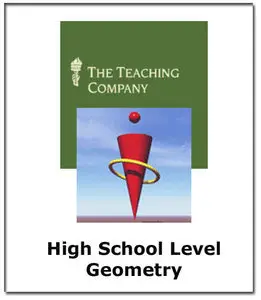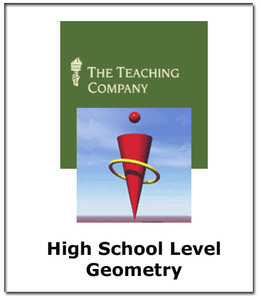High School Level - Geometry DVD
Taught by James Noggle, Pendleton Heights High School, Pendleton, Indiana / M.Ed., Ball State University | ASIN: B001FC7U1Y | 4,7 GB
Course No. 105 (30 lectures, 30 minutes/lecture)
Professor Noggle's lectures on geometry are exceptionally clear and well organized. He has an evident love for the topic, and a real gift for conveying the elegance and precision of geometric concepts and demonstrations. You will learn how geometrical concepts link new theorems and ideas to previous ones. This helps you see geometry as a unified body of knowledge whose concepts build upon one another.
For more than 30 years Professor James Noggle has been letting his students in on a secret at the high school in Pendleton, Indiana. He makes geometry feel like a long, cool drink as he guides you through the mysteries of lines, planes, angles, inductive and deductive reasoning, parallel lines and planes, triangles, polygons, and more.
In this course taught by an award-winning teacher, you develop the ability to read, write, think, and communicate about the concepts of geometry. As your comprehension and understanding of the geometrical vocabulary increase, you will have the ability to explain answers, justify mathematical reasoning, and describe problem-solving strategies.
Professor Noggle relies heavily on the blackboard and a flipchart on an easel in his 30 lectures. Very little use is made of computer-generated graphics, though several physical models of geometric objects are used throughout the lectures.
A New Way to Look at the World around You
The language of geometry is beautifully expressed in words, symbols, formulas, postulates, and theorems. These are the dynamic tools by which you can solve problems, communicate, and express geometrical ideas and concepts.
Connecting the geometrical concepts includes linking new theorems and ideas to previous ones. This helps you to see geometry as a unified body of knowledge whose concepts build upon one another. And you should be able to connect these concepts to appropriate real-world applications.
Professor Noggle’s Geometry course will begin with basic fundamental concepts used throughout the course. Students will be able to recognize and define such terms as points, planes, and angles; parallel lines, skew lines, parallel planes, and transversals; as well as the terms space, collinear, intersection, segment, and ray.
Students will discover the world of angles—symbols used for them, establishing a system of angle measurement, classifying the different types, and showing angle relationships.
The course then continues with the use of inductive reasoning to discover mathematical relationships and recognize real-world applications of inductive reasoning, conditional statements, and deductive reasoning.
Using the Fundamental Tools of Geometry
After the first few lectures introduce students to the basic terms, Professor Noggle will open the world of geometry to students. Upon completion of this course, you should be able to:
* Classify triangles according to their sides and angles
* Distinguish between convex polygons and concave polygons, and find the interior and exterior angles of convex polygons
* State and apply postulates and theorems involving parallel lines and convex polygons to solve related problems and prove statements using deductive reasoning.
* Explain the ratio in its simplest form; identify, write, and solve proportions
* Identify congruent parts of congruent triangles; state and apply the SSS, SAS, and ASA postulates; and use those postulates to prove triangles congruent
* Be able to define, state, and apply theorems for parallelograms, rectangles, rhombuses, squares, and trapezoids
* Apply proportions and concepts of proportionality in right triangles; discuss the Pythagorean Theorem
* Explore the relationships between right and isosceles triangles
* Define tangent, sine, and cosine rations for angles
* State and apply properties and theorems regarding circles and their tangents, chords, central angles, and arcs
* Address the derivation of the area formulas and apply those formulas to rectangles, squares, parallelograms, triangles, trapezoids, and regular polygons
* Define polyhedron, prism, pyramid, cylinder, cone, and sphere; and apply theorems to compute the lateral area, total area, and volume of the prism, pyramid, cylinders, cones, and spheres.
Links : http://rapidshare.com/files/295137269/h-s-l-geometry.rar
pass: avaxhome.ws
No Mirror Please



